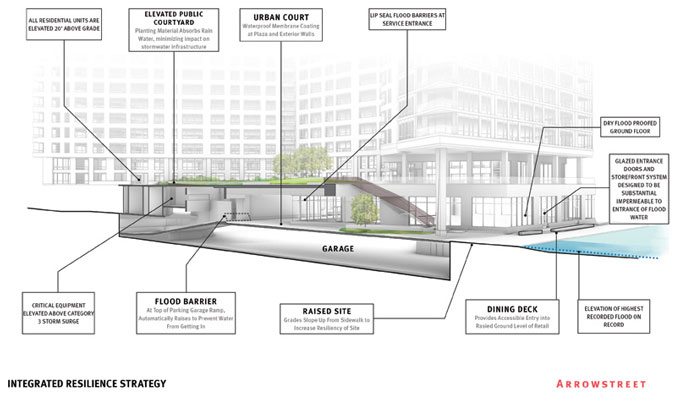Future-Proofing Through Design: Resiliency in Boston's Seaport District

The Ora mixed-use project features elements that aim to mitigate flooding.
Since 2010, the roughly 1,000-acre Boston Seaport District has rapidly developed into a vibrant neighborhood with accessible, year-round activity between Fort Point Channel, South Boston, the Marine Industrial Park and Boston Logan International Airport. Located on the far eastern edge of the Seaport, Arrowstreet's 2.5-acre Ora is poised to open this fall. It is a new gateway development with direct access to a stop on the Massachusetts Bay Transportation Authority's Silver Line bus rapid transit line.
A primary focus of this 500,000- square-foot residential, hotel, restaurant and retail development was to incorporate community-oriented urban design that also addresses the resiliency challenges of the Seaport District.
During the initial phases of design, the Massachusetts Port Authority's (Massport) floodproofing guidelines were instrumental in providing a framework to address the resiliency challenges of the Seaport District. Since many of Massport’s properties, including Ora’s Parcel K, are located on the edges of Boston's Inner Harbor, they are more prone to flooding hazards caused by extreme storms and rising sea levels. Therefore, in November 2014 Massport developed a Floodproofing Design Guide into its capital planning and real estate development processes to make its infrastructure and operations more resilient. The guidelines address both existing buildings and new construction and include information on current design flood elevations, practical applications of both wet and dry floodproofing strategies, building performance standards, how to protect critical building infrastructure systems, and the processes for review and approvals. The document will be regularly updated with the latest proven best practices and advancements in technology.
As one of the first new Massport developments to comply with the floodproofing guidelines, Ora has a variety of interwoven public spaces that accommodate a mix of uses but still offers a level of protection from rising tides and storm surges.
Water Hazards
Like much of the Boston area, including East Boston, South Bay, Cambridgeport and the Back Bay, the Seaport District is mostly filled land with an average elevation that’s just a few feet above sea level. Arrowstreet, in partnership with Lincoln Property Company and Phoenix Property Company, developed a project that could mitigate the coastal flooding risks while complying with the Federal Aviation Administration’s height restrictions due to the site’s proximity to the airport.
The design and development team took an approach to resiliency with initiatives that address immediate needs while incorporating long-term strategies. To address storm surge and rising sea levels in the near future, the development has a number of climate-resilient elements for the unique challenges within Boston’s Seaport District.

This schematic rendering shows some of the floodproofing measures at the Ora Parcel K development in Boston’s Seaport District. Courtesy of Arrowstreet
Ora is the first project in Boston to use passive flood barrier gate technology. This four-foot-tall gate protects the lower parking level and is recessed in the concrete floor at the top of the garage entry ramp. The gate is only activated by rising water.
The floodgate is actually a buoyant panel constructed of hollow aluminum extrusions. The extrusions are designed to be structural while also providing excellent floatation. The rising floodwaters create the hydrostatic pressure to float the buoyant aluminum beam and flip it into a vertical position. This process also activates self-sealing rubber gaskets located at both ends of the gate. In addition, the extrusions are chambered to provide floatation even if a panel is compromised. The cost for such a system can range from $110,000 to $124,000.
Flood-resistant aluminum doors and storefronts on the first floor are custom-designed to blend into the overall window walls and door frames and offer waterproof protection from up to four feet of rising waters. These reinforced and gasketed doors look like typical storefront systems but are designed to meet Federal Emergency Management Agency (FEMA) flood testing standards.
The project’s design specifications required in-situ testing of the assembled system. A large chamber was built on site around an exterior portion of the doors and storefront and filled with several hundred gallons of water to simulate flood conditions. The water level was elevated to four feet above the finished floor for one hour to simulate flood conditions and hydrostatic pressures. Interior seepage was measured every few minutes and compared to allowable FEMA testing standards. The installed system performed well and exceeded the required testing criteria.
Landscaping elements such as planters, sloped walks and walls that can double as outdoor seating integrate into the raised entry areas and seamlessly boost the elevation of the ground floor to further protect it from flooding. These passive systems eliminate the need for more traditional deployable flood barriers and fences that would be assembled around the entire building. Traditional systems also need a lot of storage space, a team of staff to implement and disassemble them, and regular training to anticipate flood events. Instead, integrated and passive flood resistance within the building envelope and site elements minimizes the possibility of costly mishaps and errors inherent in traditional systems.
To address long-term resiliency and climate projections, the entrance level, comprised of restaurants, retail and innovation spaces, has been elevated and dry-floodproofed to meet the design flood elevation (DFE) as recommended by the Massport floodproofing guidelines and the Boston Planning and Development Agency's Coastal Resilience Design Guidelines.
Additionally, the ground floor is much taller than typical ground-floor spaces. This allows for future adjustments to the first level if the adjacent roads and sidewalks are raised to prevent flooding. It’s a strategy that Miami Beach has evaluated to protect its assets, and it’s also one measure the city of Boston is considering through its new Coastal Flood Resilience Design Guidelines, which are expected to go into effect this year.
All residential living spaces and hotel guest rooms are also raised 20 feet above the grade level to protect residents and guests. Extensive landscape elements at the rooftop, courtyard and second levels are strategically located to absorb rainwater. The hotel and apartments are also seeking LEED Silver certification. One of the many LEED points being pursued by Ora’s owners is a Hazard Assessment prerequisite that also requires at least one of two options — Climate Related Risk Management Planning or Emergency Preparedness Planning.
Go High
To maintain uninterrupted building and service operations, all emergency generators are roof-mounted, well clear of potential floodwaters. Fuel storage tanks, electrical transformers and building operations offices are raised well above the ground floor at a secure mezzanine level. During the design phase, Arrowstreet employed its Virtual Reality Studio to present sea-level-rise scenarios and probable impacts to the site. This process allowed the client to more clearly appreciate the consequences of such events while presenting a visualization of a measured and passive response. In addition, potential storm surge and sea-level rise were presented through clear drawings, diagrams and models. This was a critical step to get all stakeholders to agree about how best to protect this asset.
The final neighborhood-oriented design solution includes a thoughtful balance of property types. The project integrates 304 units of housing, 423 spaces of underground valet parking, the 297-room Hyatt Place Boston Seaport District Hotel, flexible office space, restaurants and retail — with all programmatic elements focused on resiliency. Implementing many of these resiliency features came with some added costs that the owners were fully aware of and willingly promoted in order to protect their investment, their tenants and the residents.
In the end, the cost for these additional resiliency systems will be measured over the long-term performance of a building that should be able to withstand a major disruptive event within expected parameters, recover within an acceptable time and minimize risks to property and occupants.
Joe Sirkovich, AIA, LEED, is a senior associate with Arrowstreet.




